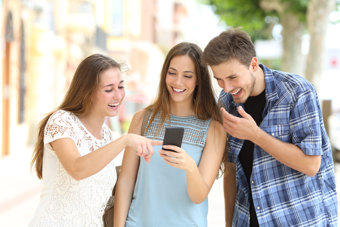The dawn of internet memes
The early internet of the 1990s saw the first digital memes emerge. One of the earliest was the 'Dancing Baby', a 3D-rendered animation of a baby performing a cha-cha dance, which went viral in 1996. You may have seen recreations of the Dancing Baby in recent years on TikTok. In many ways, it established the template for what would follow: a piece of content that was simultaneously peculiar and entertaining, perfect for sharing across early social platforms.
The evolution of meme formats
Memes have undergone significant changes in format and function since their early days, each era reflecting the cultural and technological landscape of its time.
Early 2000s: Forum memes
In the early 2000s, forums were among the main channels for us to connect through memes. This period gave rise to some of the most iconic memes that are still recognised today.
- ‘LOLcats’: This was the beginning of the image macro format—pictures combined with bold captions. LOLcats, featuring cats with “cute” misspellings (like “I Can Has Cheezburger?”), became popular, paving the way for the “image + text” meme structure that remains essential to meme culture.
- ‘Rickrolling’: Rickrolling involved tricking people into watching the music video for Rick Astley’s Never Gonna Give You Up under the guise of an unrelated link – this is called bait and switch media. It combined surprise with nostalgia and quickly became a hallmark of internet humour, showing how memes could extend beyond images.
Social media era: 2010s
The rise of social media in the 2010s created new platforms for meme sharing, allowing memes to spread at unprecedented speed and reach. Here, memes started reflecting more nuanced cultural phenomena, as they were shaped by emerging online behaviours and social trends.
- ‘Success Kid’: A photograph of a toddler with a clenched fist, embodying a small but triumphant victory, this meme became a shorthand for little, everyday wins. Success Kid’s universal appeal allowed it to be used in a range of scenarios, reflecting people’s desire to celebrate relatable everyday victories.
How different platforms shaped meme culture
As social media platforms emerged and evolved, they began influencing meme culture in distinct ways, each platform contributing its own characteristics to the meme ecosystem and changing how we create, consume, and interact with memes.
Twitter quickly became a significant hub for meme culture, allowing users to engage with trends, current events, and popular culture in real time. One of Twitter’s key contributions was the popularisation of reaction GIFs—short, looping animations that captured specific emotions or reactions. GIFs became an easy way for users to convey humour and empathy without words, adding a visual dimension to digital communication that hadn’t previously existed on such a scale.
Additionally, Twitter’s news-oriented nature made it the perfect environment for topical, news-responsive memes. Memes on Twitter often reflect current events and trending topics, with jokes and commentary arising as soon as something captures the public's attention. The rapid content turnover on Twitter has also contributed to shortened meme lifespan. Memes that might have stayed popular for weeks in the early days of the internet now often cycle in and out of relevance in a matter of days or even hours.
TikTok
TikTok introduced a fresh layer to meme culture, emphasising video, audio, and performative content in ways that no other platform had before. One of TikTok’s biggest impacts has been in creating audio memes, where users can reuse popular sounds build upon existing ideas. These sound bites have become central to TikTok’s meme culture.
TikTok’s emphasis on user-generated content has led to a highly performative meme culture, where people are encouraged to actively engage in meme-making through re-enactments, remixes, and duets. This participatory nature has made memes on TikTok far more interactive, with users often creating memes not only to watch but to replicate and build upon, making the platform a unique, community-driven space for humour and expression.
The impact on modern communication
Memes have shifted from being light-hearted entertainment to becoming essential components of digital comms. They shape the way people express emotions, ideas, and even identities.
In everyday conversation, memes act as a shorthand for complex emotions, serving as a visual language that often conveys feelings that are difficult to put into words. This has made it easier for people to share their experiences and humour in a universally relatable way, allowing memes to create a shared cultural language that transcends generations and backgrounds. Through meme references, people can quickly communicate with others who understand the same visual cues, bridging gaps between different cultures and ages.
This role in emotional expression has made memes powerful tools for bonding, especially during times of global or social upheaval; see this entire study done on meme production during the Covid pandemic.
In business and marketing
As the popularity of memes has soared, businesses have started recognising the marketing potential of meme culture. Brands now use meme-based campaigns to create relatable and engaging content that resonates with their audiences, especially on social media platforms. By adopting memes, brands can communicate in a light-hearted, often self-aware way, showing that they’re in tune with current trends.
This approach has also led brands to create unique online personalities through social media accounts that regularly engage in meme culture; see Duolingo and Ryanair. The value of memes in digital marketing has even led to the emergence of new job roles, such as “Meme Manager.” These positions reflect just how central memes have become to modern brand strategies.
Related Articles
 Cyber Security
Cyber SecurityThe go-to guide to cyber security courses (and how to choose the right one)
Discover why cyber security is essential and explore UK career opportunities, top certifications and flexible courses to start or advance your tech career.
Read More Cyber Security
Cyber SecurityBeginner’s guide to ethical hacking (and how to get certified)
Discover what ethical hacking is, why it matters and how to get certified. Start your cybersecurity journey with expert tips and career guidance.
Read More Project Management
Project ManagementSustainability in Project Management | PMP & ESG Integration
Discover how PMP-certified project managers can embed ESG and sustainability into project lifecycles, driving long-term success and responsible outcomes.
Read More Cyber Security
Cyber SecurityWhat does a cyber security analyst do? (And how to become one)
Discover what a cybersecurity analyst does, why the role matters and how to start your career in one of the fastest-growing tech sectors today.
Read More


